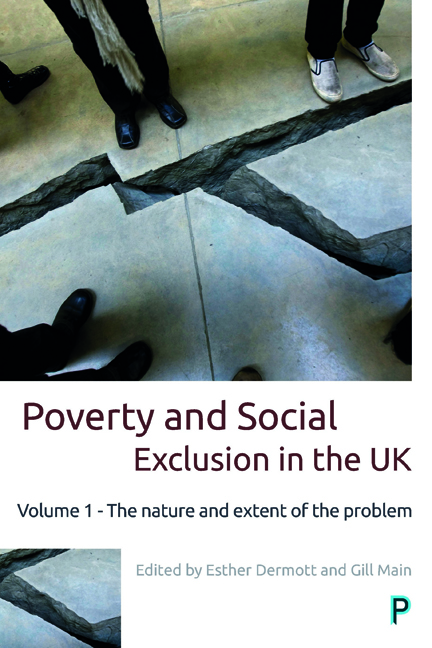Book contents
- Frontmatter
- Dedication
- Contents
- List of tables and figures
- Notes on contributors
- Acknowledgements
- Introduction: poverty and social exclusion in the UK
- One Measuring poverty in the UK
- Two The impoverishment of youth: poverty, deprivation and social exclusion among young adults in the Uk
- Three Improvement for some: poverty and social exclusion among older people and pensioners
- Four Which men and women are poor? Gender, poverty and social exclusion
- Five Better understandings of ethnic variations: ethnicity, poverty and social exclusion
- Six Improving lives? Child poverty and social exclusion
- Seven The cost of children: parents, poverty, and social support
- Eight A worsening picture: poverty and social exclusion and disabled people
- Nine Devolution and North/South division: poverty and social exclusion in the countries and regions of the UK
- Ten More similarities than differences: poverty and social exclusion in rural and urban locations
- Conclusion: innovating methods, informing policy and challenging stigma
- Technical appendix
- Index
Four - Which men and women are poor? Gender, poverty and social exclusion
Published online by Cambridge University Press: 08 April 2022
- Frontmatter
- Dedication
- Contents
- List of tables and figures
- Notes on contributors
- Acknowledgements
- Introduction: poverty and social exclusion in the UK
- One Measuring poverty in the UK
- Two The impoverishment of youth: poverty, deprivation and social exclusion among young adults in the Uk
- Three Improvement for some: poverty and social exclusion among older people and pensioners
- Four Which men and women are poor? Gender, poverty and social exclusion
- Five Better understandings of ethnic variations: ethnicity, poverty and social exclusion
- Six Improving lives? Child poverty and social exclusion
- Seven The cost of children: parents, poverty, and social support
- Eight A worsening picture: poverty and social exclusion and disabled people
- Nine Devolution and North/South division: poverty and social exclusion in the countries and regions of the UK
- Ten More similarities than differences: poverty and social exclusion in rural and urban locations
- Conclusion: innovating methods, informing policy and challenging stigma
- Technical appendix
- Index
Summary
Introduction
In this chapter we make the case for reasserting the importance of gender to poverty and social exclusion. Within mainstream policy and political debates in the UK today, gendered poverty is barely on the agenda. In the face of ongoing concerns about how to reduce childhood poverty, a focus on the role of employment, and measures based on the household which disguise gendered inequalities, gender has taken a much lower profile. However, given the continued relevance of gender to involvement in paid and unpaid work, and caring responsibilities, across the life course, we argue that gender matters for understanding poverty. Gender is also key for considering the extent and nature of social exclusion. Social exclusion in political debates tends to narrowly concentrate on levels of participation in paid employment (Pantazis and Ruspini, 2006). Instead we focus here on social relations in order to highlight how gender makes a difference to this important but neglected aspect of social exclusion.
We also argue that academics and policy makers need to reconfigure gendered poverty as more than simply studying ‘poor women’. While on a global scale women remain substantially more disadvantaged than men (Gornick and Boeri, 2016), within the most developed countries, including the UK, it is not uniformly the case that all women are worse off (Dermott and Pantazis, 2015a). Therefore, as noted by Bennett and Daly (2014) researching gender should not only mean studying the lives of women; a gendered perspective needs to explore the experiences of different groups of men as well. Moreover, in advancing thinking about the relationship between gender and living standards, we adopt a life course perspective, which focuses on integrating different aspects of individuals’ gendered experience of poverty, and avoids the problem of simply ‘adding gender on’ to other significant variables. Our analysis therefore explores the circumstances of both women and men, and how gender intersects in significant ways with age and household type. This is consistent with evidence highlighting that age and household living arrangements do make a substantial difference to levels of poverty (Bennett and Daly, 2014).
Gender, poverty and social exclusion: what we know
Academic, political and policy discussions of gendered poverty in the UK over the last thirty plus years has taken inspiration from the ‘feminisation of poverty’ thesis (Goldberg, 2010).
- Type
- Chapter
- Information
- Poverty and Social Exclusion in the UK Vol 1The Nature and Extent of the Problem, pp. 95 - 114Publisher: Bristol University PressPrint publication year: 2017



